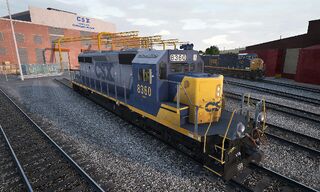Introduction[]
The 3,000-horsepower, six-axle (C-C) SD40-2, as part of Electro-Motive’s “Dash 2” line, made its debut in 1972. Through 1986, Electro-Motive produced nearly 4,000 SD40-2s, making the locomotive one of the most successful diesel locomotives of all time.
Powered by EMD’s reliable two-cycle, 645-series diesel power plant, and wellsuited to virtually any type of mainline service, from fast intermodal duty to lugging heavy coal tonnage, the SD40-2 was purchased by more than 30 railroads, including giants Burlington Northern, Union Pacific, and CP Rail. During the time the SD40-2 was in production, CSX did not yet exist, but CSX’s predecessors were active buyers. Thus, with the creation of CSX in 1986 and its acquisition of half of Conrail in 1999, CSX came to own more than 300 SD40-2s. Today, the venerable EMD SD40-2 remains a front-line locomotive for CSX, found across its system (and frequently on Sand Patch Grade) handling duties ranging from heavy haul to totting priority auto traffic.
Description[]
The SD40-2’s popularity in the headquarters of railroad companies was, it turns out, largely matched among the engineers who grasped the locomotive’s throttle. Versatile, reliable, and with the quick power loading typical of EMD’s two-cycle diesel power plant, the SD40-2 was a welcome assignment for most engine crews. The SD40-2 was beloved by crews for another trait: One CSX engineer said, “The SD40-2s are absolutely the best riding locomotives I was ever on in my life. They ride like Cadillacs.”
The 3,000-horsepower, six-axle (C-C) SD40-2, as part of Electro-Motive’s “Dash 2” line, made its debut in January 1972. Kansas City Southern 637 was the first SD40-2 and given that the “Dash-2s” were viewed as natural extensions of EMD’s “40 line” introduced in 1966, there was not extraordinary buzz around the locomotive’s debut. For train-watchers, the SD40-2 looked quite like its SD40 predecessor, the major visual difference being the Dash-2’s high-adhesion (HT-C) truck. To accommodate the longer HT-C truck, the SD40-2 itself was three feet longer than its predecessor SD40, which resulted in long end-platforms that some wags immediately likened to “porches.”
The relatively quiet debut of the SD40-2 initially extended to sales performance, and for its first two years (1972-73) the SD40-2 failed to top production of 350 units a year. SD40-2 production continued for the most part to march along at a comfortable but not remarkable pace of between 300 and 400 units per year through 1977. Then it all changed. The SD40-2 like many success stories in is truth a mix of a quality product and a timely dose of good luck: The SD40-2s 645-series power plant, introduced in the “40 line,” by this time had proven strong and reliable. And the improvements made with the “Dash 2s”, including solid-state, circuit-board electronic components that both improved performance and made trouble-shooting and repairs easier, were boons. EMD reported reliability improvements of 15 percent compared to prior models.
As for the good fortune, at the end of the 1970s and into the early 1980s, the SD40-2 found itself positioned amid a “perfect storm” of favorable conditions: The general economy rebounded and with it railroad traffic loadings and motive power replacements that had been deferred were addressed; long-sought work rules changes were on the horizon and would allow the railroads to better compete with the trucking industry, and, foremost, came “the boom:” the explosion of Powder River Basin coal traffic. To tote millions of tons of low-Sulphur coal from the Powder River Basin of Wyoming and Montana to electricity-generating power stations throughout the plains states, Midwest, and Southeast, railroads quite literally lined up for new motive power.
During three years (1978-1980) a total of more than 2,100 SD40-2s (including variants) were delivered. Burlington Northern would eventually amass a fleet of more than 800 SD40-2s, Union Pacific bought 685 and through its subsequent mergers with Missouri Pacific, Rio Grande, C&NW, and Katy, the UP would eventually call upon over 1,000 SD40-2s. When production of SD40-2s ended in 1986, it was clear the appeal of the landmark locomotive had, in truth, extended far beyond the Wyoming coal fields – in the eastern U. S., the Louisville & Nashville purchased 199 units, Conrail acquired 167, and Norfolk & Western 162. In Canada, CP Rail alone purchased nearly 500 SD40-2s.
During the time the SD40-2 was in production, CSX did not yet exist, but its predecessors had been active buyers: In addition to the units purchased by the Louisville & Nashville and Conrail, the Baltimore & Ohio (Chessie) purchased 20, Seaboard Coast Line acquired 36, and Clinchfield five units. Thus, with the creation of CSX in 1986 and its acquisition of half of Conrail in 1999, CSX came to own more than 300 of the versatile six-axle locomotives. Due to their various prior ownerships and heritages, CSX’s SD40-2s display a variety of detail variations such as headlight placements and the like. Today, the SD40-2 remains a front-line locomotive for CSX, found across its system (and frequently on Sand Patch Grade) handling duties ranging from heavy haul to totting priority auto traffic. And via CSX’s “SD40-3” rebuilding program the veteran EMD units no doubt will serve for many more years to come.
Operators[]
BNSF[]
A version of the loco in BNSF pumpkin orange livery is available in the Cajon Pass DLC.
CSX Transportation[]

CSX Transportation inherited a large number of SD40-2 from its predecessors, primarily the Chessie System, Conrail, Louisville & Nashville Railroad and the Seaboard System. The locomtotive first appeared in the CSX Heavy Haul Beta in the Yn3b 'Box Car' livery, currently the most recent CSX livery. In update 1.4, the yn2 'Bright Future' livery was added. The locomotive was featured in the CSX Heavy Haul Beta and the final version of Sand Patch Grade along with the AC4400CW and GP38-2. The CSX version features a cold start option and the majority of the controls are operational.
Union Pacific[]
A version of the loco in Union Pacific yellow livery is available in the Cane Creek and Sherman Hill DLCs.
Timetable[]
The SD40-2 runs a 24 hr timetable on Sand Patch Grade, Cane Creek, and Sherman Hill. Links can be found below to the appropriate timetables:
- Service Timetable: Sand Patch Grade
- Service Timetable: Cane Creek
- Service Timetable: Sherman Hill
- Service Timetable: Cajon Pass
Operating the Locomotive[]
Information on operating this loco can be found here. Information on operating the Alerter safety system can also be found here.
| CSX Heavy Haul | |
|---|---|
| Locomotives | AC4400CW - GP38-2 - SD40-2 |
| Rolling Stock | BethgonII® Coal Gondola - Husky Stack® 53-foot Container Car - 89-foot Bi-Level Auto Rack - 5201-Cubic Foot Covered Car - 30,500 Gallon Tank Car - 50 foot Plate C Boxcar |
| Locations | Cumberland - Sand Patch - Shaw Mine - Rockwood Mine |
| Operators | CSX Transportation |
| Tutorials | Intro Sequence Tutorial - Yard Switching - Locomotive Turntable - Locomotive Refuelling - AC4400CW Introduction - Coal Loading - Train Brakes: Theory - SD40-2 Introduction - GP38-2 Introduction |
| Scenarios | Sand Patch Summit - A Helping Hand - Clear Cut - Fully Fuelled - Cumberland Charge - Ice and Snow - Powering America Part 1 - Powering America Part 2 - Cumberland Switchback |
| Journeys | GP38-2 Engineer - SD40-2 Engineer - AC4400 Engineer |
| Guides | Driving the SD40-2, GP38-2 and GP40-2 - Driving the AC4400CW - The Alerter - Switching/Shunting - Loading Coal - CSX Collectibles |
| Miscellaneous | Signalling - Service Mode Timetable |
| DLC | CSX GP40-2 - CSX C40-8W |
| Cane Creek | |
|---|---|
| Locomotives | AC4400CW - SD40-2 |
| Rolling Stock | Three-Bay Covered Hopper - 5201-Cubic Foot Covered Car - 30,500 Gallon Tank Car - Two-Bay Aggregate Hopper Car |
| Locations | Thompson - Brendel - Arch - Lee - Seven Mile - Emkay - Postash |
| Operators | Union Pacific |
| Training | AC4400CW Introduction - SD40-2 Introduction |
| Scenarios | Tank Car Setouts - Siding to Siding - LDG-51 Part 1:Thompson to Seven Mile - LDG-51 Part 2:Seven Mile to Potash - LDG-51 Part 3:Potash to Thompson - LDP-46 Part 1:Brendel to Moab - LDP–46 Part 2:Brendel to Moab – All Long The Line - The Big Mine - Mine to Mainline - Follow the Dirt Train - Canyon Explorer |
| Journeys | Chapter 1 - Cane Creek Tutorials - Chapter 2 - Mainline Running - Chapter 3 - The "Dirt Train" Moab Local - Chapter 4 - The Potash Local - Chapter 5 - Free Roam Operations - Chapter 6 - A Whole Day of Cane Creek |
| Sherman Hill | |
|---|---|
| Locomotives | SD70ACe - SD40-2 |
| Rolling Stock | 60-foot plate F Boxcar - Reefer Car - 89-foot Bi-Level Auto Rack - 5201-Cubic Foot Covered Car - 30,500 Gallon Tank Car - Bethgon® Coal Gondola - Husky Stack® 53-foot Container Car |
| Locations | Cheyenne - Granite Canyon Quarry - Buford - Sherman Hill Summit - Hermosa - Laramie |
| Operators | Union Pacific |
| Training | Sherman Hill Railroad Introduction - SD70ACe Introduction - SD40-2 Introduction - Hill Start Training Module |
| Scenarios | Something Old, Something New - Switcheroo- Get Over It - Magnet for Trouble - Sandbox Switching |
| Journeys | Chapter 1 - Your First Rodeo - Chapter 2 - Making the Grade - Chapter 3 - Switching it Up - Chapter 4 - Cheyenne Getter - Chapter 5 - Gullywasher |
| DLC | Union Pacific Heritage Collection |
| Cajon Pass | |
|---|---|
| Locomotives | ES44C4 - SD40-2 |
| Freight Wagons | 89-foot Bi-Level Auto Rack - 30,500 Gallon Tank Car - 50 foot Plate C Boxcar - Maxi Stack IV - Bulkhead Flat Car - 3-Bay Covered Hopper |
| Locations | Barstow Old Yard - Barstow - Barstow Shops - Oro Grande Aggregate - Victorville Cement Plant - Victorville - Hesperia - Cajon Pass Summit - San Bernardino - San Bernardino West - San Bernardino South |
| Operators | BNSF |
| Training | Route Intro - ES44C4 Training Module - Long Train and Brakes Introduction - Hill Start and Dynamic Brake Introduction - Training Module |
| Scenarios | Shop Class - Through Fire and Flames - Barstow-away - Slip'n'Sline - Command & Concrete - Free Switching |
| Journeys | Rookie - Ups and Downs - SoCal Chords - Trial by Fire - This Switcher - Concrete Results - Sorted - Season of Storms |
| Miscellaneous | Driving the ES44C4 - Service Timetable |
| DLC | Santa Fe F7 - BNSF SD70ACe |
| American and Canadian Locomotives and Multiple Units | |
|---|---|
| 4-Axle Diesel Locomotives | F7 - F40PH-2 - F40PH-3 - F125 - GP9 - GP38-2 - GP40-2 - MP36PH-3C |
| 6-Axle Diesel Locomotives | AC4400CW - C40-8W - ES44AC - ES44C4 - SD40 - SD40-2 - SD70ACe |
| Switchers | SW1000R - MP15DC |
| Electric Locomotives | ACS-64 - ALP-46 |
| Electric Multiple Units | M3 - M7 - M9 - Amtrak Acela |
| Non-Powered Control Units | Amfleet Cab Car - Bombardier Bi-Level Cab Car - Gallery Cab Car - CTC-3 - Rotem Commuter Car |
